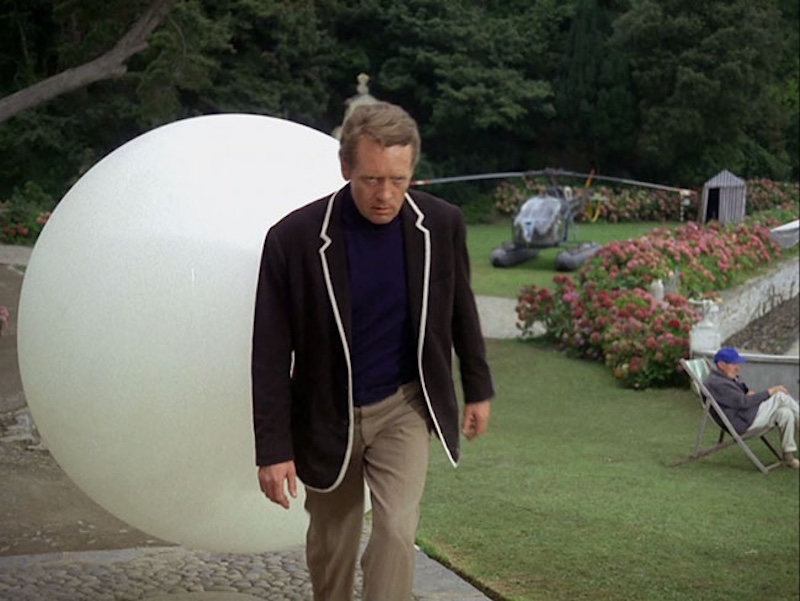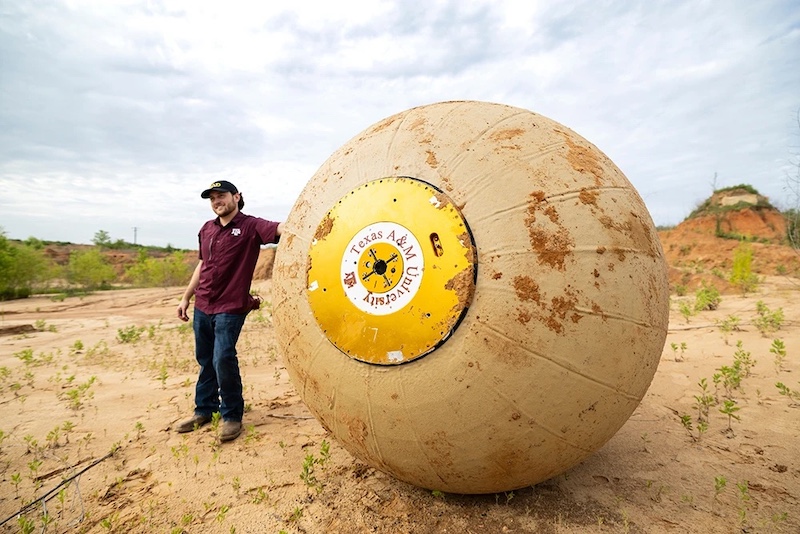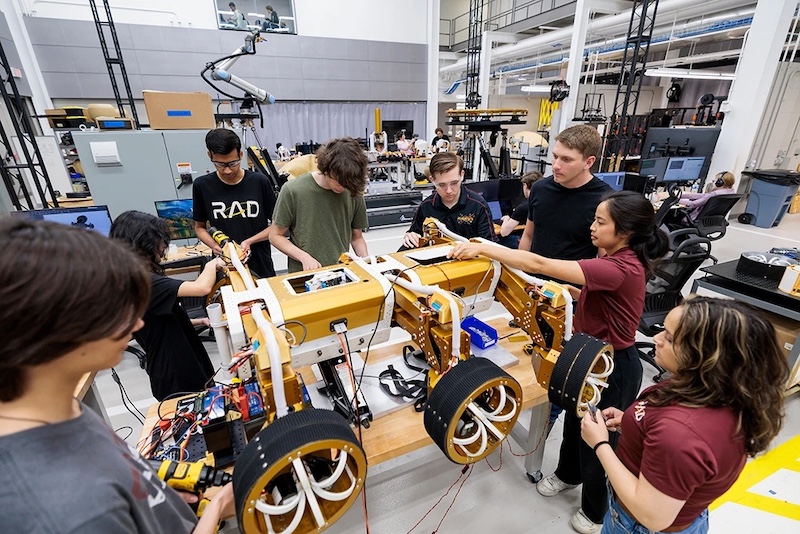At Texas A&M University, a modest building on the Rellis campus houses one of the most ambitious robotics programs in the United States.
Inside, robots are being built to explore craters on the Moon, traverse flooded terrain on Earth, and maybe one day change the way humans and machines work together in extreme environments.
Leading it all is Dr Robert Ambrose, a NASA veteran who spent decades at the Johnson Space Center before joining Texas A&M in 2021.
Ambrose is the director of the Robotics and Automation Design (RAD) Lab, where he oversees projects that combine student creativity, engineering skill, and the kind of experimentation that made NASA famous.
“I’ve always enjoyed prototyping,” Ambrose said. “Going back to when I was a kid, I was always designing and building things.”
At NASA, Ambrose led the Software, Robotics and Simulation Division, where he worked on the Robonaut – a humanoid robot designed to assist astronauts – as well as rovers and exoskeletons.
“I really enjoyed prototyping new ideas, and the first branch that I led was kind of the technology branch that developed new prototypes,” he said.
“I was teaching the young engineers and old engineers just how to do prototyping, to think about a problem, try different ideas and to rapidly do that, where you weren’t taking years to come up with a solution.”
When he arrived at Texas A&M, he found the same hunger for hands-on innovation. “I found A&M had a hunger for that and this idea of mixing research engineers and grad students together. And I knew a little bit about that and said, ‘OK, I think this is going to be a good place for me’.”
The ball that can’t fall over
Among Ambrose’s projects, one stands out – the RoboBall. First conceived in 2003 while Ambrose was at NASA, it’s a perfectly spherical robot that can’t flip over, no matter what terrain it encounters.
With funding from the Chancellor’s Research Initiative and the Governor’s University Research Initiative, Ambrose revived the project after joining Texas A&M.
Graduate students Rishi Jangale and Derek Pravecek have taken charge of the research and development.
“Dr. Ambrose has given us such a cool opportunity. He gives us the chance to work on RoboBall however we want,” said Jangale. “We manage ourselves, and we get to take RoboBall in any direction we want.”
Pravecek added, “We get to work as actual engineers doing engineering tasks. This research teaches us things beyond what we read in textbooks. It really is the best of both worlds.”
At its core, RoboBall is what the students call a “robot in an airbag”. The smaller RoboBall II prototype measures about two feet in diameter and is used for power and control tests.
The larger RoboBall III spans six feet and is built to carry payloads such as sensors or sampling tools. Upcoming trials will test its ability to move from water to land on the beaches of Galveston.
“Traditional vehicles stall or tip over in abrupt transitions,” Jangale explained. “This robot can roll out of water onto sand without worrying about orientation. It’s going where other robots can’t.”
The students admit that maintenance isn’t simple. “Diagnostics can be a headache,” said Pravecek. “If a motor fails or a sensor disconnects, you can’t just pop open a panel. You have to take apart the whole robot and rebuild. It’s like open-heart surgery on a rolling ball.”
There’s no manual for this kind of work. “Every task is new,” said Jangale. “We’re very much on our own. There’s no literature on soft-shelled spherical robots of this size that roll themselves.”
But the surprises keep coming. “When it does something we didn’t think was possible, I’m always surprised,” Pravecek said. “It still feels like magic.”
The team set a new record when RoboBall II reached 20 miles per hour. “We didn’t anticipate hitting that speed so soon,” Pravecek said. “It was thrilling, and it opened up new targets. Now we’re pushing even further.”
Ambrose is quick to credit the team. “The autonomy Rishi and Derek have is exactly what a project like this needs,” he said. “They’re not just following instructions – they’re inventing the next generation of exploration tools.”
RoboBall’s versatility could make it useful both in space and on Earth. “Imagine a swarm of these balls deployed after a hurricane,” Jangale said. “They could map flooded areas, find survivors and bring back essential data – all without risking human lives.”
And, for those who remember television from another era – yes, the giant rolling sphere does look suspiciously like the eerie white “Rover” from The Prisoner, the 1960s show in which Patrick McGoohan was chased down a beach by an oversized ball.

Texas A&M may not have meant it that way, but we saw a resemblance because our twisted minds work that way.
(Thanks also to Robohub, the nonprofit that originally published this story and has long supported independent robotics journalism. They’ve been kind to small publishers – including us – by allowing free republication of their work.)
Building a lab and a legacy
Ambrose founded the RAD Lab in 2022 with just five graduate students. Today, the lab includes 31 members – a mix of research engineers and students – working on projects such as Marsupial, a system that deploys smaller specialized robots; Rover Rescue, a tethered recovery robot for stranded rovers; and REV (Robotic Exploration Vehicle), a multi-limbed rover for planetary missions.
As research engineer Vidur Zimmerman explained, “We have a bunch of teams led by a variety of students and full-time engineers working on various projects, including mobile robots, robotic manipulators and others.
“We really have a good team here, where it’s a mix of grad students and engineers. It’s a one-to-one ratio, so we really have the opportunity here to collaborate and work toward those long-term goals and projects.”
Ambrose emphasizes the importance of character in his team. “My dad used to tell me, ‘You can coach everything except probably character,’” he said. “I’m looking for character in the employees. We’ve only hired people that I think are really good people.”
Mechanical engineering doctoral student Stephen Hester said the lab’s culture makes even failures worthwhile.
“Any time a robot breaks or something doesn’t work, it’s a learning opportunity,” explained Amrose. “And the way we approach problems in the lab is, ‘OK, stop. What did we learn from this?’ It’s not, ‘Oh, no, everything’s wrong, everything’s bad’.
“Pause. Think about this. What can we learn from this? What can we improve?”
Ambrose also sees today’s students as pioneers. “We’re at an amazing moment in robotics where students today are doing things that used to not be possible except with large teams,” he said.
Training the next generation
Each summer, the RAD Lab hosts 30 to 40 undergraduates for a 10-week program. “They spend the whole summer working with grad students and professional research engineers,” Ambrose said. “They can picture themselves leading a team as a grad student. And it’s changed their lives.”
He believes this model prepares them for industry better than traditional coursework. “You’ve got to be able to think fast and get a quick testable product that can be evaluated. And then you learn from it and rinse and repeat. That’s what we’re teaching here,” he said.
From Texas to the stars
Now also the associate director of the Texas A&M Space Institute, Ambrose will soon test robots like RoboBall and REV in simulated lunar and Martian terrain.
As he put it: “Give creative minds a challenge and the freedom to explore, and you’ll see innovation roll into reality.”
If RoboBall’s progress is any indication, Texas A&M’s robotics program isn’t just on the move – it’s on a roll.


